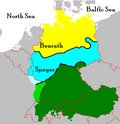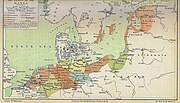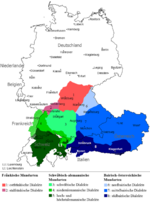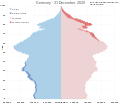of German was considerably reduced. Significant dialects such as the East Pomeranian dialect, most varieties of Silesian German, Prussian dialects and...
23 KB (2,718 words) - 16:19, 28 August 2024
Low German has not undergone the High German consonant shift, as opposed to Standard High German, which is based on High German dialects. Low German evolved...
115 KB (8,372 words) - 23:46, 27 September 2024
Palatine German (Standard German: Pfälzisch [ˈp͡fɛlt͡sɪʃ] , endonym: Pälzisch) is a group of Rhine Franconian dialects spoken in the Upper Rhine Valley...
8 KB (618 words) - 09:45, 9 September 2024
rarely Alemannish (Alemannisch, [alɛˈman(ː)ɪʃ] ), is a group of High German dialects. The name derives from the ancient Germanic tribal confederation known...
15 KB (1,262 words) - 13:49, 3 August 2024
Standard German is based on a combination of Thuringian-Upper Saxon and Upper Franconian dialects, which are Central German and Upper German dialects belonging...
144 KB (14,413 words) - 23:28, 29 September 2024
and Dresden. Austria High German (Hochdeutsch in Österreich, not to be confused with the Bavarian Austria German dialects) has the same geographic origin...
24 KB (2,365 words) - 21:27, 26 September 2024
The High German languages (‹See Tfd›German: hochdeutsche Mundarten, i.e. High German dialects), or simply High German (Hochdeutsch) – not to be confused...
10 KB (893 words) - 13:01, 27 August 2024
which modern dialect maps are based. For this reason the dialects may be termed "monastery dialects" (German Klosterdialekte). The main dialects, with their...
44 KB (4,425 words) - 06:45, 29 September 2024
dialects in other countries is restricted or even endangered. The dialects that comprise Swiss German must not be confused with Swiss Standard German...
70 KB (7,773 words) - 12:12, 26 September 2024
Bavarian language (redirect from Austro-Bavarian dialects)
000 sq mi), making it the largest of all German dialects. In 2008, 45 percent of Bavarians claimed to use only dialect in everyday communication. Bavarian...
27 KB (2,208 words) - 17:35, 5 September 2024
dialects, with locally varying degrees of influence of the initial dialects. Swabian can be difficult to understand for speakers of Standard German due...
19 KB (1,405 words) - 08:46, 20 August 2024
more widely understood than other dialects and as a Central German dialect, was felt to be "halfway" between the dialects of the north and south. Luther...
41 KB (3,567 words) - 03:21, 22 September 2024
southern dialects experience the shift of voiced to voiceless stops, with the shift of /d/ to /t/ found in Upper German and in some Central German dialects, while...
32 KB (3,054 words) - 11:57, 26 September 2024
standard German. For most this would be rare and confined to those who have learned German at school or through work. As with other dialects, various...
22 KB (1,561 words) - 13:11, 17 August 2024
(‹See Tfd›German: Hessisch) is a West Central German group of dialects of the German language in the central German state of Hesse. The dialect most similar...
8 KB (775 words) - 03:03, 11 June 2024
the first ethnically German families settled in the United States in Jamestown, Virginia, in 1608, the German language, dialects, and different traditions...
55 KB (5,517 words) - 22:55, 16 August 2024
The official language of Germany is German, with over 95 percent of the country speaking Standard German or a dialect of German as their first language...
13 KB (1,098 words) - 11:57, 5 August 2024
often spoken. Swiss Standard German differs from Swiss German, an umbrella term for the various Alemannic German dialects (in the sense of "traditional...
24 KB (2,295 words) - 21:39, 22 September 2024
rivers, Low German began to retreat in favour of High German dialects already during Late Medieval times (cf. Wittenberg whose name is Low German but whose...
42 KB (4,798 words) - 19:03, 18 August 2024
Georgian dialects German dialects Malayalam languages Varieties of Malay Connacht Irish, Munster Irish, Ulster Irish Italian dialects Japanese dialects Korean...
60 KB (6,974 words) - 08:46, 30 September 2024
Pennsylvania Dutch language (redirect from Pennsylvania German (language))
dialects; it is believed that in the first generations after the settlers arrived, the dialects merged.[citation needed] The result of that dialect levelling...
48 KB (4,732 words) - 02:07, 28 August 2024
north-eastern Germany as well as by minorities in northern Poland. Together with West Low German dialects, it forms a dialect continuum of the Low German language...
8 KB (818 words) - 04:55, 16 August 2024
Germanic languages (redirect from Germanic dialects)
Continental West Germanic includes German (standard register and dialects), as well as Dutch (standard register and dialects). East Germanic includes most...
93 KB (9,514 words) - 11:22, 27 September 2024
Upper German (‹See Tfd›German: Oberdeutsch [ˈoːbɐdɔʏtʃ] ) is a family of High German dialects spoken primarily in the southern German-speaking area (Sprachraum)...
29 KB (2,895 words) - 22:51, 5 September 2024
Saxon dialects are considered Westphalian, with the notable exception of Gronings, which is grouped with the Northern Low Saxon and Friso-Saxon dialects.[citation...
8 KB (762 words) - 11:57, 14 September 2024
Walser German (‹See Tfd›German: Walserdeutsch) and Walliser German (Walliserdeutsch, locally Wallisertiitsch) are a group of Highest Alemannic dialects spoken...
26 KB (2,206 words) - 06:30, 21 August 2024
there were also class-based dialects, or sociolects. For example, Schönbrunner Deutsch (Schönbrunn German), or German as spoken by the courtiers and...
13 KB (1,385 words) - 06:28, 22 June 2024
East Central dialects are the closest to Standard German (chiefly as a written language) among other German dialects. Modern Standard German thus evolved...
5 KB (299 words) - 18:02, 4 September 2024
Christoph Gottsched) and East Franconian German. East Central German dialects are mainly spoken in Central Germany and parts of Brandenburg, and were formerly...
7 KB (488 words) - 10:13, 15 April 2024
Charter. German dialects – some quite distinct from the standard language – are used in everyday speech, especially in rural regions. Many dialects, for example...
222 KB (9,265 words) - 12:04, 28 September 2024




















